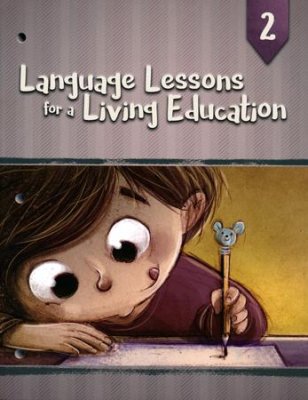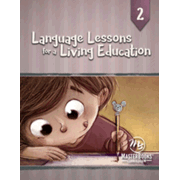Master Books has published a language arts curriculum for grades one through ten titled Language Lessons for a Living Education. I wrote a lengthy review of the first book published, the second-grade course. When the other courses were published, I decided to keep this review and write separate reviews for the others. You can read my reviews of level 1, levels 3 through 6, and levels 7 through 10.
This course was written for Christian students, and Christian content shows up sporadically in both reading material and exercises.
Grammar, phonics, reading, composition work, vocabulary, and spelling are all covered. Handwriting is the only area of language arts for which you might need another resource unless your child is a struggling reader.
Language Lessons for a Living Education 2 is contained in one full-color book. A few pages of information at the beginning explain how the course works, and an answer key is at the back. Children will write and draw directly in the book. The perforated and three-hole-punched pages can easily be removed, completed, and stored in a binder.
The course requires frequent interaction between parent and child. While you can work with a couple of children in the course at the same time, it requires too much individual interaction to work well for a large group class. While parents need to teach the course, no advance preparation is needed, so it is easy to use—just open and go.
While the book looks like a traditional language arts course, it reflects the influence of Charlotte Mason's methodology as well. Picture studies, narration, drawing, copywork, memorization, and recitation are all incorporated into lessons. However, these methods are not always applied according to Mason’s recommendations since they tend to be designed to elicit specific answers rather than leaving it to a child to decide what is of interest to them. For example, picture studies (based upon pictures created expressly for the course rather than actual works of art) are accompanied by specific questions rather than using Mason’s more open-ended approach. The picture on page 71 shows a mother goat with her two kids. Among the questions asked are: “What are the goats doing?” and “What colors are used in this picture?” Similarly, activities labeled Narration Practice often ask comprehension questions rather than asking the student to relate what he or she heard. Nevertheless, the course offers students more opportunities to say, write, or draw what they think or feel than do traditional-style courses.
Lessons are laid out for each week with an opening activity, instruction, and an exercise for the first day and instruction and/or an exercise for each of the following four days. On the first day of every other week, the opening activity is reading a short story featuring two friends. Their adventures are featured in stories throughout the course. In the alternate weeks, the opening activity is either a picture study or reading a poem or a psalm. Stories, poems, and psalms are meant to be read aloud together by parent and child, with the child reading as much as he or she is able. In a unique twist, some of the easier lines have been highlighted to make it easy to identify lines children should be able to read with no trouble, but children can always read more. Questions almost always follow the reading or picture study. As mentioned above, questions tend toward comprehension, but they do include some open-ended questions such as, “What was the story about?” and “How does this picture make you feel? Why?”
The lesson following the opening activity for the first day generally reviews phonics and reading skills and sometimes includes memorization activities for scripture or poetry. Students will be memorizing 1 Corinthians 13 throughout the year, two verses at a time.
On the second and third days of each week, students study grammar and punctuation. Brief instruction is followed by exercises in a traditional fashion, but don’t miss pages 403 through 414 which present activities and games that you might use to reinforce reading skills and grammar in a more enjoyable fashion. Some activities and games require two or more players, but some can be used with just one child. These are not referenced within lessons, so it is up to you to determine when, how, or if to use them. Similarly, copywork on pages 427 through 442 can be used at your discretion.
The fourth day shifts direction, asking students to create their own very short story, poem, or psalm. Frequently, they are also provided with space to draw a picture. Prompts in the form of scenarios and questions help children write or draw about a particular topic. Children might narrate their story aloud, and they might also write part of it on a few lines provided in the book. Parents can decide how much to help their children with written work.
The fifth day reverts toward structure as students work on vocabulary and spelling. Lists of spelling words to be presented each week are provided beginning on page 419. Parents can add other words that a student needs to master, writing each week’s words on a reproducible form that they give to the student. Pages 415 and 416 describe several games and activities to use for spelling practice. There are no prescribed spelling activities other than for students to write out their words, so these pages are important if you want students to review and practice spelling. For vocabulary, there are reproducible pages for students to create their own dictionary, writing a word and a simple definition, then adding a picture. Instructions say that students should use their weekly spelling words for this for at least the first three quarters of the year. They can always add other words and are encouraged to do so for the fourth quarter. While I think this activity is worthwhile, the way pages are laid out (space designed for four words per page) means that words will not be arranged in alphabetical order. I would recommend cutting the completed pages apart (using only one side per page) and then arranging words in a box or container in alphabetical order. (Students can practice putting words in alphabetical order with this setup!)
Students are expected to complete independent reading throughout the year. An Independent Reading List form helps you keep track of books read.
Two methods of assessment are provided. Assessment Charts at the back of the book show key objectives taught each week, followed by two columns. One is headed “Skill Mastered,” while the other says “Needs Experience.” This type of observational assessment should work fine, but there are also four quarterly quizzes that you can use if you prefer that method.
The overall approach is gentler than most traditional programs. Parts of speech are introduced, but only nouns, pronouns, adjectives, and verbs, rather than all eight parts of speech. Exercises have large lines for writing and often require circling, matching, or something other than writing words. Children are given opportunities for self-expression and creativity as well as for memorization and recitation. Overall, this creates a very workable balance between traditional and Charlotte Mason approaches that should be especially appealing to parents who like the predictable structure of traditional programs yet want to give their children more opportunities for personal expression.
Note: Practice Makes Polished 2 offers supplemental lessons aligned with Language Lessons for a Living Education 2. Also, video instruction for this course is offered at MasterBooksAcademy.com.










